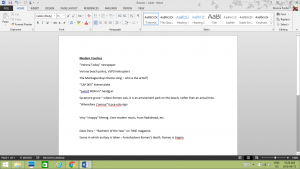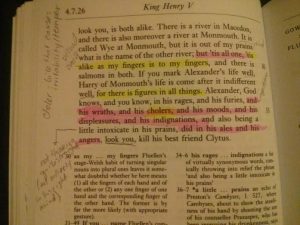When taking notes, I have various techniques depending on what medium I am using. If I am watching a film, I often tend to be more detailed in describing exactly what I am taking notes on, whereas annotating a text allows me to have context-dependent notes. It is not possible for me to write directly on the screen of the movie (although technology is constantly improving), so I choose to type my notes. Handwritten notes are fantastic for absorbing material that is being lectured on, however, for film, I want to be able to get my thoughts down as quickly as possible to avoid missing the consequent scenes. Hence, typing as I watch is the most effective medium for me to annotate film.

While taking notes about film, I often have to make reference to which scene I am talking about. If watching a film on my laptop, I could type out exactly what time in the film I am taking notes on, however, if I am watching on a television screen, I am not afforded such luxury. In that case, I typically start a note with a description of what is happening, such as I did when watching Luhrmann’s Romeo and Juliet, “In the scene in which Romeo and Juliet are looking at each other through the fish tank…”. The nice thing about taking notes on film is that I am not restricted in the length of annotation. If I need to, I can pause the movie and type down an infinite amount of thoughts about a particular scene in a word document.
Film is entertaining. It is much easier to keep my attention towards looking for the details when I am watching a movie over a text. The work is done for me. The story unfolds itself and I can just sit back and watch. Reading text requires far more focus. Reading is a much more active process than watching, so the notes tend to be superficial unless I dedicate enough energy to re-reading the text through multiple times.
When reading a paper copy of a play, on the other hand, I am able to annotate with a pen directly onto the text. There are numerous advantages to this, for example, I am able to find my notes that correlate directly to the section of text I am thinking about by merely flipping to it. The literature is there, and so are the notes I have written in the margins. However, a disadvantage to this method is that there is a space limitation. The font size I write with needs to be small enough to fit in all that I need to say, while still being legible to myself.

In the context of this class, Shakespeare and Film, I find that if I read a Shakespeare play and then watch a film on it, I will be focusing primarily on visual artistry, music and acting. Very rarely while watching a Shakespeare film do I focus on the words being spoken, unless I have not read the play. In doing so, most of my film notes tend to focus on technical aspects of the film and visual details, since I have already read the dialogue and know how the story progresses. My annotation of text, especially Shakespeare is often more of a translation of the language than attempting to find something very insightful. However, as I read more Shakespeare in this class, I have found that it is becoming easier to understand what is being said. This allows me to reflect more thoughtfully on the subject matter, rather than be overwhelmed with the ancient language.
While annotating either film or text, I have found that it is best to not use a one-size-fits-all approach, and contemplate exactly which medium of note-taking works best which each art form. For film I choose type-written and for text I choose to write in the margins. Each technique selected allows for me obtain the information I need to thoroughly understand the story.
Leave a Reply
You must be logged in to post a comment.